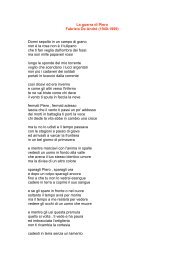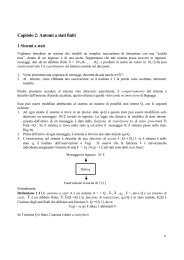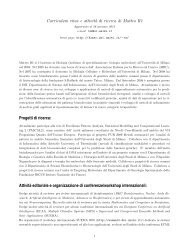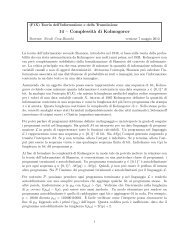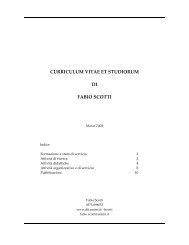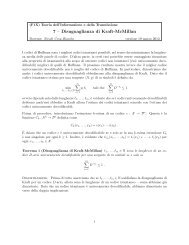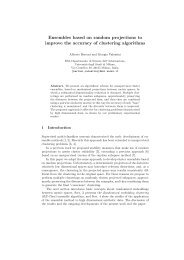- Page 1: Università degli Studi di Milano -
- Page 4 and 5: ii Indice 3.2.2 Filtri di Chebysche
- Page 7 and 8: Capitolo 1 Segnali e Sistemi I conc
- Page 9 and 10: 1.1. Segnali e Informazione 3 p Ese
- Page 11 and 12: 1.2. Classificazione dei Segnali 5
- Page 13 and 14: 1.3. Sistemi per l’Elaborazione d
- Page 15 and 16: 1.3. Sistemi per l’Elaborazione d
- Page 17 and 18: 1.3. Sistemi per l’Elaborazione d
- Page 19: 1.3. Sistemi per l’Elaborazione d
- Page 23 and 24: 1.3. Sistemi per l’Elaborazione d
- Page 25 and 26: 1.3. Sistemi per l’Elaborazione d
- Page 27 and 28: Capitolo 2 Analisi in Frequenza di
- Page 29 and 30: 2.1. Numeri Complessi 23 y 0 θ r r
- Page 31 and 32: 2.2. Segnali Periodici 25 Esempio 2
- Page 33 and 34: 2.4. Serie di Fourier 27 questa sez
- Page 35 and 36: 2.4. Serie di Fourier 29 -T -T/2 T/
- Page 37 and 38: 2.5. Trasformata di Fourier 31 Pass
- Page 39 and 40: 2.5. Trasformata di Fourier 33 con
- Page 41 and 42: 2.5. Trasformata di Fourier 35 Anch
- Page 43 and 44: 2.5. Trasformata di Fourier 37 Tabe
- Page 45 and 46: 2.5. Trasformata di Fourier 39 Modu
- Page 47 and 48: 2.6. Energia di un Segnale e Relazi
- Page 49 and 50: 2.7. Risposta in Frequenza dei Sist
- Page 51 and 52: 2.7. Risposta in Frequenza dei Sist
- Page 53 and 54: 2.7. Risposta in Frequenza dei Sist
- Page 55 and 56: 2.8. Modulazione e Demodulazione in
- Page 57 and 58: 2.8. Modulazione e Demodulazione in
- Page 59 and 60: 2.9. Modulazione e Demodulazione in
- Page 61 and 62: 2.9. Modulazione e Demodulazione in
- Page 63 and 64: 2.9. Modulazione e Demodulazione in
- Page 65: 2.9. Modulazione e Demodulazione in
- Page 68 and 69: 62 Filtri Analogici di valutare la
- Page 70 and 71:
64 Filtri Analogici Guadagno Osserv
- Page 72 and 73:
66 Filtri Analogici Linearità dell
- Page 74 and 75:
68 Filtri Analogici Η(ω) 1 0.707
- Page 76 and 77:
70 Filtri Analogici Η(ω) 1 N=2 N=
- Page 78 and 79:
72 Filtri Analogici R C L Resistenz
- Page 80 and 81:
74 Filtri Analogici Il comportament
- Page 82 and 83:
76 Filtri Analogici V R R Analogame
- Page 84 and 85:
78 Filtri Analogici V 1.6 κΩ 1.6
- Page 86 and 87:
80 Conversione Analogico-Digitale d
- Page 88 and 89:
82 Conversione Analogico-Digitale F
- Page 90 and 91:
84 Conversione Analogico-Digitale f
- Page 92 and 93:
86 Conversione Analogico-Digitale 4
- Page 94 and 95:
88 Conversione Analogico-Digitale I
- Page 96 and 97:
90 Conversione Analogico-Digitale f
- Page 98 and 99:
92 Conversione Analogico-Digitale 4
- Page 100 and 101:
94 Conversione Analogico-Digitale 4
- Page 102 and 103:
96 Conversione Analogico-Digitale t
- Page 104 and 105:
98 Conversione Analogico-Digitale 1
- Page 106 and 107:
100 Conversione Analogico-Digitale
- Page 108 and 109:
102 Conversione Analogico-Digitale
- Page 110 and 111:
104 Conversione Analogico-Digitale
- Page 112 and 113:
106 Trasformata Discreta di Fourier
- Page 114 and 115:
108 Trasformata Discreta di Fourier
- Page 116 and 117:
110 Trasformata Discreta di Fourier
- Page 118 and 119:
112 Trasformata Discreta di Fourier
- Page 120 and 121:
114 Trasformata Discreta di Fourier
- Page 122 and 123:
116 Trasformata Discreta di Fourier
- Page 124 and 125:
118 Trasformata Discreta di Fourier
- Page 126 and 127:
120 Trasformata Discreta di Fourier
- Page 128 and 129:
122 Architetture DSP f(t) SISTEMA S
- Page 130 and 131:
124 Architetture DSP Per quanto det
- Page 132 and 133:
126 Architetture DSP CLK STA ADR1 L
- Page 134 and 135:
128 Architetture DSP I bit della pa
- Page 136 and 137:
130 Architetture DSP MOLTIPLICATORE
- Page 138 and 139:
132 Architetture DSP effettuata in
- Page 140 and 141:
134 Trasformata Zeta e Sistemi LTI
- Page 142 and 143:
136 Trasformata Zeta e Sistemi LTI
- Page 144 and 145:
138 Trasformata Zeta e Sistemi LTI
- Page 146 and 147:
140 Trasformata Zeta e Sistemi LTI
- Page 148 and 149:
142 Trasformata Zeta e Sistemi LTI
- Page 150 and 151:
144 Trasformata Zeta e Sistemi LTI
- Page 152 and 153:
146 Trasformata Zeta e Sistemi LTI
- Page 154 and 155:
148 Trasformata Zeta e Sistemi LTI
- Page 156 and 157:
150 Trasformata Zeta e Sistemi LTI
- Page 158 and 159:
152 Trasformata Zeta e Sistemi LTI
- Page 161 and 162:
Capitolo 8 Filtri Digitali a Rispos
- Page 163 and 164:
8.1. Filtri FIR e IIR 157 Passando
- Page 165 and 166:
8.2. Applicazioni di Filtri FIR e I
- Page 167 and 168:
8.2. Applicazioni di Filtri FIR e I
- Page 169 and 170:
8.2. Applicazioni di Filtri FIR e I
- Page 171 and 172:
8.3. Progetto di Filtri Digitali 16
- Page 173 and 174:
8.3. Progetto di Filtri Digitali 16
- Page 175 and 176:
8.3. Progetto di Filtri Digitali 16
- Page 177 and 178:
8.3. Progetto di Filtri Digitali 17
- Page 179 and 180:
8.3. Progetto di Filtri Digitali 17
- Page 181 and 182:
8.3. Progetto di Filtri Digitali 17
- Page 183 and 184:
8.4. Realizzazione di Filtri Digita
- Page 185 and 186:
8.4. Realizzazione di Filtri Digita
- Page 187 and 188:
8.4. Realizzazione di Filtri Digita
- Page 189 and 190:
8.4. Realizzazione di Filtri Digita
- Page 191 and 192:
8.4. Realizzazione di Filtri Digita
- Page 193 and 194:
8.4. Realizzazione di Filtri Digita
- Page 195 and 196:
8.4. Realizzazione di Filtri Digita
- Page 197:
8.4. Realizzazione di Filtri Digita
- Page 200 and 201:
194 Processi Stocastici e loro Cara
- Page 202 and 203:
196 Processi Stocastici e loro Cara
- Page 204 and 205:
198 Processi Stocastici e loro Cara
- Page 206 and 207:
200 Processi Stocastici e loro Cara
- Page 208 and 209:
202 Processi Stocastici e loro Cara
- Page 211 and 212:
Capitolo 10 Risposta di Sistemi a S
- Page 213 and 214:
10.1. Risposta di Sistemi a Segnali
- Page 215 and 216:
10.1. Risposta di Sistemi a Segnali
- Page 217 and 218:
10.2. Rumore Impulsivo 211 Questo i
- Page 219:
10.2. Rumore Impulsivo 213 Filtro m
- Page 222 and 223:
216 Filtri di Wiener 11.1 Formulazi
- Page 224 and 225:
218 Filtri di Wiener In questo caso
- Page 226 and 227:
220 Filtri di Wiener • il filtro
- Page 228 and 229:
222 Filtri di Wiener • Se i proce
- Page 231:
Bibliografia [1] J. D. Gibson. Prin




![1) [4] Cos'è un hazard? Uno stallo? Cos'è una pipeline multiple ...](https://img.yumpu.com/16431383/1/190x245/1-4-cose-un-hazard-uno-stallo-cose-una-pipeline-multiple-.jpg?quality=85)
